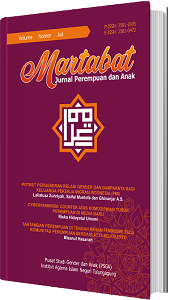Abstract
Social-relational lives among both female and male children often experience various problems of gender injustice, which are manifested in the form of gender stereotype. The aim of this paper is to analyze some aspects of gender stereotype and their implications for social resilience towards children especially in context of relations between both female and male children and also for their environment. The data collection relies on two aspects, first is literature study and second is interview which is conducted for one expert whose background is as an academician and also an activist for children rights. This study asserts that gender stereotype has been done since childhood, even before the child has been born. The stereotype is perpetuated through various socializations: through families, schools, and the general public environment. Gender stereotype has an impact on children’s social resilience, particularly on how children react it among society. The difference of perceptions in children with society expectations makes them feel confused, insecure, and uncomfortable among society.
References
Ackerman, B. P., Brown, E. D., dan Izard, C. E. “The relations between persistent poverty and contextual risk and children's behavior in elementary school,” Developmental Psychology, 40(3), 2004, hlm: 367-377.
Arivia, G. Feminisme: sebuah kata hati, Jakarta: Kompas Gramedia, 2000.
Bian, L., Leslie, S., dan Cimpian, A. “Gender stereotypes about intellectual ability emerge earlu and influence children’s interests,” Science, Vol. 355, 2017, hlm: 389-391.
Cacioppo, J. T., Reis, H. T., dan Zautra, A. J. “Social Resilience: The Value of Social Fitness With a Application to the Military,” American Psychological Association, Vol, 66 No. 1, 2011, hlm: 43-51.
Cannon, T. “Reducing people’s vulnerability to natural hazards communities and resilience,” WIDER Research Paper 2008 (34).
Corwin, A. “Language and gender variance: Constructing gender beyond the male/female binary,” Electronic Journal of Human Sexuality, Vol. 12, 2009.
Coyne, S. M., Linder, J. R., Rasmussen, E.E, Nelson, D. A. dan Collier, K. M. “It’s a bird! It’s a plane! It’s a gender stereotype! Longitudinal associations between superhero viewing and gender stereotyped play,” Sex Roles 70(9–10), 2014, hlm: 416–430.
Eddyono, S. W. Women’s Empowerment in Indonesia, A Poor Community in Jakarta, New York: Routledge, 2019.
Elliott, G. “Exploring Non-binary Gender Identities,” Tesis, 2017.
Fakih, M. Analisis Gender dan Transformasi Sosial, Yogyakarta: Pustaka Pelajar, 2006.
Fine, C. dan Rush, E. “Why Does All The Girl have to Buy Pink Stuff? The Ethics of Science and Gendered Toy Marketing Debate,” Journal of Business Ethics, 149, 2018, hlm: 769-784.
Grusec, J. E., “Socialization Processes in the Family: Social and Emotional Development,” Annual Review of Psychology, Vol. 62, 2011, 243-269.
Hilliard, L. J. dan Liben, L. “Differing Level of Gender Salience in Preschool Classrooms: Effects of Children’s Gender Attitute and Intergroup Bias,” Child Development, 81(6), 2010, hlm: 87-98.
https://theconversation.com/riset-tenaga-kesehatan-perempuan-himpitan-peran-gender-sangat-pengaruhi-karier-mereka-129219 (diakses 1 Juli 2020).
Keck, M. dan Sakdapolrak, P., “What Is Social Resilience? Lesson Learned and Ways Forward,” Erdkunde, Vol. 67 No. 1, 2013, hlm: 6-19.
King, T., Meehl, A. dan Priest, N. “Building Children’s Resilience through Respectful and Gender Equitable Relationships Pilot Project, A literature review,” CSRM Working Paper Nomor 4, 2018, hlm: 1-33.
Levitt, H. M., dan Ippolito, M. R. “Being Transgender: the experience of transgender identity development,” Journal of Homosexuality, 61(12), 2014, hlm: 27-58.
Lorenz, D. F. “The diversity of resilience: contribution from a social science perspective,” Natural Hazard: Journal of The International Society for The Prevention and Mitigation of Natural Hazards, 67, 2013, hlm: 7-24.
Maas, M. K. “Ada identitas gender dalam mainan anak; untuk menghilangkannya butuh upaya lebih serius,” https://theconversation.com/ada-identitas-gender-dalam-mainan-anak-untuk-menghilangkannya-butuh-upaya-lebih-serius-131663 (diakses pada 6 Juni 2020).
Macrae, C. N., Stangor, C., dan Hewstone, M. Stereotypes and Stereotyping, New York: The Guilford Press, 1996.
Marshall, N. A. dan Marshall, P. A. “Conceptualizing and operationalizing social resilience within commercial fisheries in northern Australia,” Ecology and Society 12(1), 1, 2007.
Mulia, S. M. Ensiklopedia Mulimah Reformis, Pokok-Pokok Pemikiran untuk Reinterpretasi dan Aksi, Jakarta: Dian Rakyat, 2019.
Mulvey, K. L. dan Killen, M. “Challenging gender stereotypes: resistance and exclusion,” Child Development 86(3), 2015, hlm: 681–694. Norris, K. “Can a four-year-old be sexist?” https://theconversation.com/can-a-four-year-old-be-sexist-75547 (diakses pada 1 Juli 2020).
Nugroho, R. Gender dan Strategi Pengarus-utamaannya di Indonesia. Yogyakarta: Pustaka Pelajar, 2008.
Orwella, Citra dan Khabibur Rohman, “Imaji Salehah dalam Media Sosial Instagram dalam Kasus Rina Nose”, Martabat: Jurnal Perempuan dan Anak. 1 (2), 2017
Prastyani, A. W. “Riset tenaga kesehatan perempuan: himpitan peran gender sangat pengaruhi karier mereka,”
Siahaan, R. “Ketahanan Sosial Keluarga: Perspektif Pekerjaan Sosial,” Informasi, Vol. 17 No. 2, 2012, hlm: 82-96.
Tierney, H. Women’s Studies Encyclopedia, Westpot, CT: Greenwood Press, 1999.
Zaduqisti, E. “Stereotipe Peran Gender Bagi Pendidikan Anak,” MUWÂZÂH, Vol. 1, No. 1, Januari-Juni 2009, hlm: 73-82.

Martabat: Jurnal Perempuan dan Anak is licensed under a Creative Commons Attribution-ShareAlike 4.0 International License.

